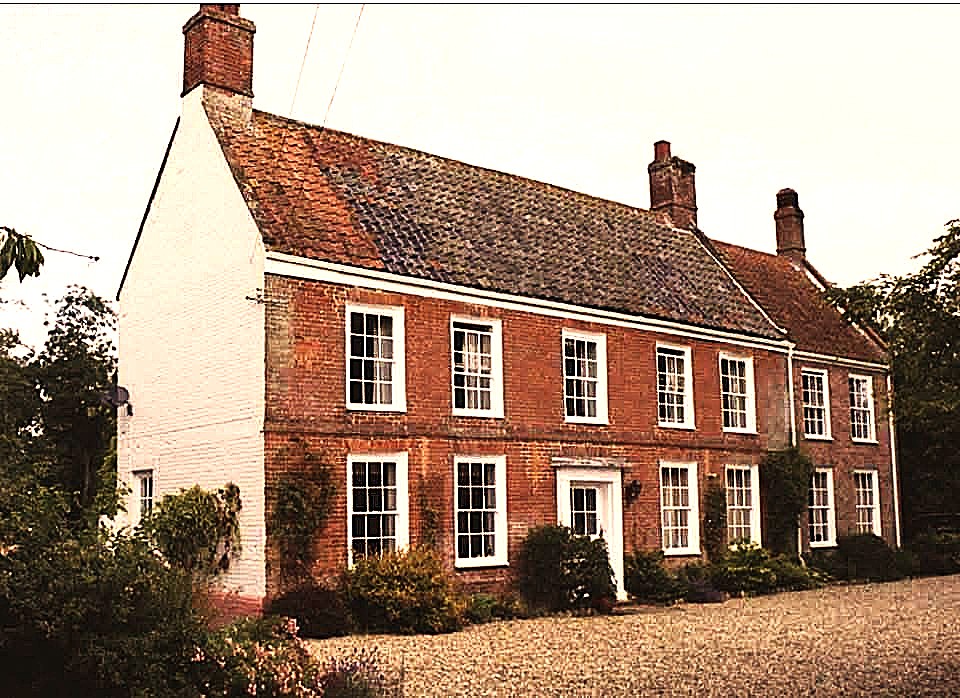Tasburgh House, Ipswich Road

Faden's map of Norfolk, published in 1797 seems to show just some nearby farm buildings whereas the Enclosure Award map of 1818 clearly shows Tasburgh House. It was owned by the Rev. Philip Hopson Stannard who had been born at Mulbarton Hall, the son of a wealthy Norwich cloth merchant. Although he was ordained as a deacon at Norwich Cathedral, before becoming a curate at Stoke Holy Cross, he had no connection to Tasburgh church, other than later becoming a church warden. In 1801 he had bought what he described as a manor house and farm in the village, Old Hall Farm, for himself and his widowed mother, and it seems likely that it was he who built Tasburgh House as a rather more suitable residence for a gentleman of that time. The Manorial Court records indicate that in 1808 he borrowed money secured by a mortgage on his Tasburgh properties and it seems possible that this was to pay for the building of the house. Philip's mother died in 1812 but he continued living in Tasburgh, and a newspaper report in January 1817 records that a thief entered his house and stole £30 in notes (a large sum in those days), some cash, an old family watch and other articles from the parlour, leaving a note on the table with the words "I'm off!" After Philip Stannard sold up in 1837 and moved to Long Stratton, Tasburgh House continued to be home to the farming tenants of Old Hall Farm for many years, with the house at Old Hall farm being divided into two or more dwellings for farm labourers or other poorer families.
The purchaser of Tasburgh House and the majority of the Rev. Stannard's land and other properties in the village was Alexander Campbell, a property investor from Little Plumstead, and the occupier of the house was his tenant, William Betts a thirty year old farmer from Attlebridge who in 1841 was unmarried but had two female and two male resident servants. The farm extended to over 200 acres, which in those days would have been regarded as a substantial holding, and was by a long way the biggest in Tasburgh. The picture remained unchanged in 1851, but by 1861 he had married, had two young sons, William and Arthur, and employed in the house a domestic maid, a dairy maid and a groom. Unfortunately his wife Harriett died the following year aged 44, and he never remarried. William Betts continued to farm until his death in 1877 when he was succeeded by his eldest son who, being unmarried, retained the services of both a housekeeper and a general servant at the time of the 1881 census and he was still shown as the occupant of Tasburgh House ten years later, by which time his brother Arthur had taken on the tenancy of Elms Farm before they both moved to Wroxham.
By then, the owner Alexander Campbell had died in 1882, and although Old Hall Farm had been purchased by Sir Charles Harvey of Rainthorpe Hall, it isn't clear whether he also bought Tasburgh House and the adjoining Lodge farm from Mr Campbell's estate. Certainly it wasn't part of the Rainthorpe Estate at the time of the 1927 auction following Sir Charles' death, but it is known that he had sold off a number of properties during his lifetime, including the nearby High Road Farm and Hill Farm. In any event, the tenancy had changed by 1892 when Kelly's Norfolk Directory names the property as Tasburgh House, occupied by Edward Warmill, a farmer, but there then seems to have been a succession of farmers, with Horace Foulger in occupation at the time of the census in 1901, and Kelly's naming Charles Reynolds as the farmer in 1904, although none of them farmed Old Hall Farm. By 1922 Kelly's directory gives another farmer, Arthur Hovell as the occupant of Tasburgh House but towards the end of the 1930s it seems the house had ceased to be a farmhouse as by 1937 the occupant and possibly owner was a Captain Fisher who William Moore, in his memories of growing up in Tasburgh, said was there during WW2. In the 1970s the house was owned by Michael Ashken, a urology consultant at the Norfolk and Norwich hospital, and his wife Iris, who was also a doctor, and it was they who sold off the adjoining barn for conversion to residential use and extended the main house by adding the northern third of its frontage. They remained at Tasburgh House for over thirty years before moving to Harleston in 2006.